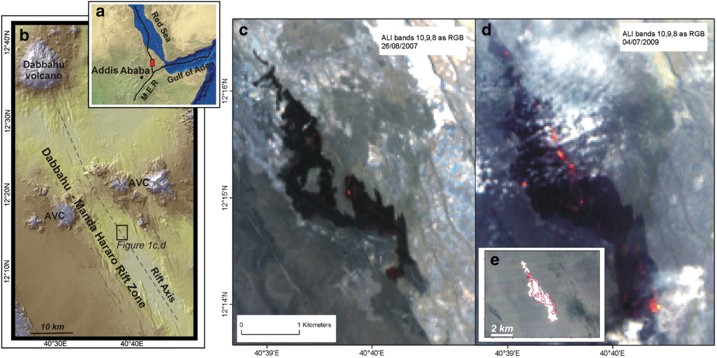Recent rift-related volcanism in Afar, Ethiopia by D.Ferguson et al, 2010
Non-technical summary
Most of the magmatic activity on Earth is concentrated along rift zones, that is the boundaries along which tectonic plates move apart. This involves both the eruption of lava at the surface, mainly from fissures in the ground, and also the intrusion of magma into the shallow crust (i.e. a few kilometres below the surface). However, as most rift zones lie beneath the oceans, the opportunities available to study the ‘rifting’ process, and the volcanic activity associated with it, are very rare. This means that the typical volcanic ‘characteristics’ of rift systems are not generally well understood. The current rifting events in Afar therefore, present an exceptional opportunity to study the relationships between volcanism and how the crust grows along rift zones. In this paper two recent volcanic eruptions (August 2007 and June 2009) have been studied using some several types of satellite data and also field observations made during visits to the eruption sites. Through these observations the characteristics of both the eruptions (size, duration, chemical composition etc) have been established. Both were relatively brief events (around 36–72 hours), and the lava was erupted from linear fissures around 4-6.5km in length. From satellite images of the sulphur dioxide clouds released during eruptions and also the extent of the lava flows on the ground we have estimated that around 5 and 15 million cubic metres of lava were erupted in Aug 2007 and June 2009 respectively.

Figure 1 (above). Figure 1a shows the location of the rift zone (red box) in Afar in northern Ethiopia. 1(b) show the topography of around the rift and the location of the new fissures (in the box). 1(c), (d) and (e) are satellite images taken during the eruptions in 2007 (c) and 2009 (d and e). The black material is newly erupted lava, some of which is still hot (shown by the red colour).
Full paper (PDF file)
